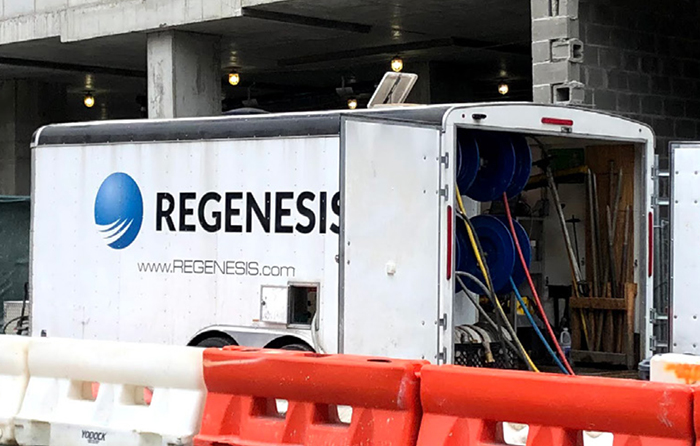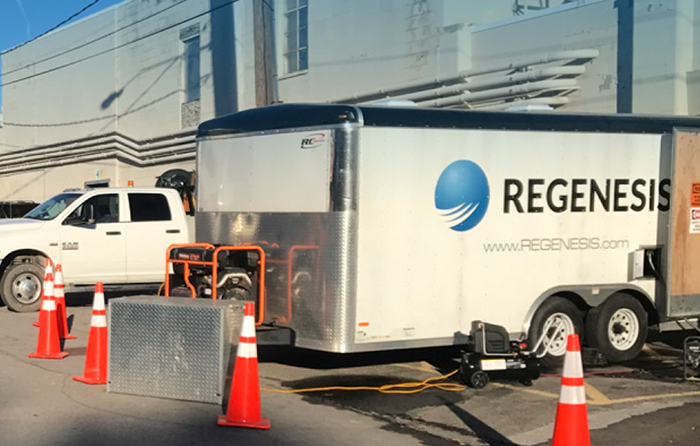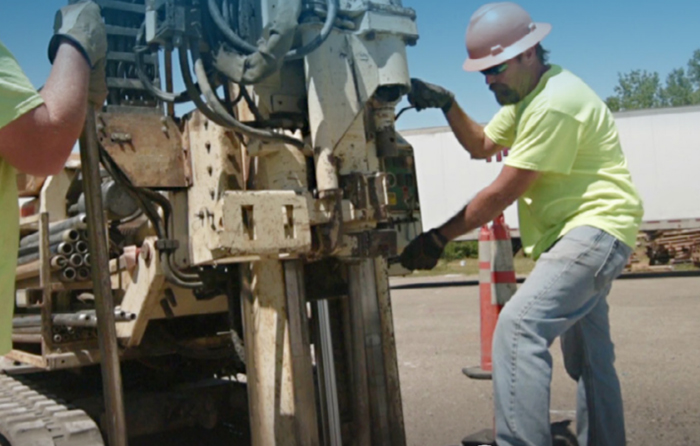PFAS and CVOC Remediation Paves the Way for Mixed-Use Tower
Case study highlights:
- Certificate of Completion Awarded through New York State’s Brownfield Cleanup Program
- Combined remedy approach using ISCO and colloidal activated carbon to successfully treat CVOC and PFAS contaminants
- Greater than 90% reductions in mass flux achieved at property boundary
This case study reviews a legacy brownfield site in New York that was found to have high concentrations of chlorinated volatile organic compounds (CVOCs), petroleum hydrocarbons (PHCs), 1,4-dioxane, and PFAS (per- and polyfluoroalkyl substances). To address this contamination, a combined remedy was implemented: PersulfOx® was applied to reduce contaminant mass at the source, while a PlumeStop® barrier was installed to prevent residual migration beyond the site boundary. This approach resulted in a 90% reduction in groundwater contaminant concentrations and significantly lowered the mass flux at the property boundary. The success of the remediation effort earned the site a Certificate of Completion through New York State’s Brownfield Cleanup Program, paving the way for environmentally responsible redevelopment in this commercially valuable area
Reducing Time and Cost-to-Closure at UST Release Sites
Case study highlights:
- BJAAM has successfully closed four sites, achieving NFA status, with one additional site pending agency review and another site set for a secondary application to address MTBE levels.
- BJAAM develops, stores, and accesses their own PetroFix remedial application designs using the PetroFix Design Assistant
- Site outcomes have led to significant cost savings for BJAAM’s clients and gained confidence from state UST regulatory agencies
The case studies included in this multi-site review include sites where a leading Ohio Valley environmental consulting firm BJAAM Environmental, Inc. effectively used PetroFix in supporting their risk-based corrective action (RBCA) site closure strategy. BJAAM pioneered a streamlined corrective action approach to reduce the time required for achieving site closure, minimizing project costs for its clients. Their approach combines expertly applied Risk-Based Corrective Action (RBCA) with remedial actions and/or institutional controls designed to achieve site-specific target levels (SSTLs) for petroleum contaminants in well-defined areas of concern. PetroFix aligns with BJAAM’s strategy for managing UST sites as a remedial technology, rapidly reducing and sustaining PHC contaminants below cleanup targets to expedite regulatory closures. The PetroFix in situ treatment approach has proven to be an effective and low-cost solution to address UST releases through various state agency programs.
Closure Achieved at Formerly Used Defense Site
Case study highlights:
- PetroFix application reaches No Further Action at UST release site
- Site meets stringent North Carolina Groundwater Quality Standards (NCGWQS)
- Visual confirmation in soil cores and monitoring wells allows the field crew to make real-time adjustments to ensure proper distribution
This case study reviews a former Naval Auxiliary Air Station located in the Outer Banks region of North Carolina. After a thorough evaluation of viable remedies for petroleum contamination, the project team opted for an in-situ injection of PetroFix® Remediation Fluid to remediate the contaminants through a combination of sorption and bioremediation by adding electron acceptors. The goal for this site is to achieve closure as cost-effectively as possible. Site closure is most directly achieved by reducing contaminant concentrations below the applicable NCGWQS for four consecutive sampling events. This sorption-enhanced biostimulation approach was evaluated as the most viable, cost-effective means to to reach the NCGWQS targets and achieve site closure in a reasonable timeframe.
PetroFix Eliminates Hydrocarbon Plume Migration
Case study highlights:
- Permeable reactive barrier installed in underground car park in Northern Italy
- The barrier has stopped the offsite migration of a petroleum hydrocarbon plume onto a public road and archeological site.
- The in situ remediation has met the stringent cleanup target, positioning the site for regulatory closure, despite the challenges posed by the restricted access onsite.
This case study explains the installation of a PetroFix permeable reactive barrier below a new office building in Northern Italy. An excavation was conducted over a limited footprint to remove some of the more highly impacted soils. Beyond the excavation limits, pressure grouting was conducted to stabilize the residual soil contamination, prior to construction commencing. Once construction was completed, Planeta Studio Associato, a leading environmental consultancy based in Italy, collaborated with REGENESIS to develop an in situ remediation plan for treating the groundwater contaminant plume.
In Situ PFAS Remediation Protects Offsite Environment at Airport in Norway
Case study highlights:
- SourceStop® Liquid, a colloidal activated carbon (CAC), was applied as a permeable sorptive barrier to reduce PFAS migration hydraulically.
- The permeable sorptive barrier was designed and implemented downstream of the excavation area to mitigate the ongoing dissolved-phase transport of PFAS during and post-excavation.
- Through nine months of monitoring, the two primary PFAS of concern, PFOA and PFOS, have been reduced by 96% and 98%, respectively, while Total PFAS has been reduced by 94%.
At Haugesund Airport in Norway, Avinor and their environmental consultant COWI implemented a remediation plan to reduce the migration of PFAS (per- and polyfluoroalkyl substances) in groundwater from a fire training ground. An in situ remediation solution was used to minimize the further migration of PFAS in groundwater during and after the source removal measures were completed.
Petroleum Plume Mitigated to Protect Flathead Lake
Case study highlights:
- PetroFix barrier stops Benzene and other hydrocarbons from entering Flathead Lake, the largest natural freshwater lake west of the Mississippi River
- A permeable reactive barrier (PRB) using PetroFix determined to be the most viable and cost-effective strategy to quickly halt plume’s movement toward the lake
- Benzene concentrations remain non-detect for 3.5 years thus far
In the 1990s, environmental investigations of a legacy petroleum hydrocarbon release in downtown Polson, MT identified a large undefined light non-aqueous phase liquid (i.e., LNAPL) plume, with benzene and other contaminants migrating toward Flathead Lake. Following a comprehensive review of remedial alternatives, environmental consultant WCEC determined that installing a permeable reactive barrier (PRB) using PetroFix Remediation Fluid would be the most viable and cost-effective strategy to quickly halt the dissolved phase plume’s movement toward the lake. Following the installation of the PetroFix PRB, the threat of dissolved phase contaminant migration into the lake was immediately mitigated, with these results sustained for over 3.5 years thus far, as performance monitoring continues.
New York Brownfield Achieves Site Closure
Case study highlights:
- Based on successful performance results, a pump-and-treat system was decommissioned in 2020, and the NYSDEC granted the site closure in August 2021
- By not having to operate and maintain the pump-and- treat system, substantial energy and cost savings were realized in this period
- Roux’s agile site management, making the switch from an ex situ to a PlumeStop in situ approach, saved time and money for their client
This case study reviews a former metals manufacturing facility in upstate New York contaminated with chlorinated volatile organic compounds (CVOCs) from the plating operations, predominantly comprised of tetrachloroethene (PCE) and trichloroethene (TCE). A previously installed groundwater pump-and-treat system significantly reduced CVOC concentrations in groundwater. However, after a few years, the reinjection wells became clogged and no longer accepted water. This required modification of the approach. The ex situ pump-and-treat remedy maintained plume control. However, to continue this approach would have required well replacement. Additionally, these systems are well known to reach an asymptotic boundary condition above the low, part-per-billion cleanup targets for CVOCs and are prone to rebound once shut down. Such was the case at the site. In response to these conditions, Roux (formerly Benchmark), a leading engineering and redevelopment consulting company, quickly adapted the remedial strategy, favoring an in situ approach to achieve the project objectives and facilitate site closure.
Site Goals Met Within 60 Days
Case study highlights:
- TCE contribution to the plume was eliminated following the application.
- This reduction has been continuously maintained more than three years post-application.
- The highly controlled PlumeStop injection resulted in no surfacing inside the building.
This case study reviews the site of a large-scale in situ groundwater treatment of trichloroethene (TCE) at a former industrial manufacturing facility in the Midwest that quickly achieved and then sustained performance objectives. TCE and low concentrations of other chlorinated volatile organic compounds (CVOCs), cis-1,2-dichloroethene, vinyl chloride, and 1,1,1-trichloroethane, were treated using an innovative sorption-enhanced reductive dechlorination (ERD) approach virtually eliminating contaminants by the first monitoring event within 60 days of application. A permeable reactive barrier (PRB), installed at the site property boundary, has maintained 100 percent reduction in TCE for over three years, meeting the application’s performance objectives by cutting off the site’s contribution to a more extensive groundwater TCE plume.
Combined Remedy Rapidly Achieves Targets to Address Chlorinated Solvent Impacts
Case study highlights:
- A multi‑faceted remedial solution mitigates CVOC contamination beneath an active business
- Successful application overcomes challenging site conditions
- Use of advanced colloidal remediation technologies from REGENESIS accelerates site toward closure with Regional Water Quality Control Board (RWQCB)
This case study reviews an active industrial facility in Southern California where PlumeStop and S-MicroZVI successfully treated CVOC contamination. The combined remedy quickly reduced CVOC concentrations below targets, priming the site for future regulatory closure. The responsible party retained Roux, a leading environmental remediation consultant, to complete the remediation project. Specifically, the remedy needed to (1) reduce CVOCs in soil, soil vapor, and groundwater to background contamination levels; (2) minimize disruption to the site tenant occupying the building; (3) coordinate with offsite property owners to complete the work; and (4) complete all work within established budgets and timeframes.
Treatment Solution for Large TCE Plume Saves Client $380,000
Case study highlights:
- Large TCE plume effectively treated using combined technology solution from REGENESIS, including PlumeStop and S-MicroZVI
- Accurate mapping of CVOC flux zones using FluxTracers saves $380,000 in project costs
- Safe and efficient installation meets time and budget requirements
This case study reviews a former manufacturing facility in Indianapolis that had released high levels of chlorinated solvents into the groundwater, creating a large plume extending to the White River. A combined in situ biogeochemical reduction solution rapidly mitigated the threat to river and saved the client $380,000. Wilcox Environmental Engineering, Inc., a leading engineering and consulting firm based in Indianapolis, was hired by the responsible party to investigate the site. After evaluating the remedial options, Wilcox worked with REGENESIS to design a solution for in situ remediation of the TCE plume using biogeochemical reduction in the onsite plume area and sorption-enhanced chemical reduction in the offsite plume. This approach entailed placing permeable reactive barriers (PRBs) perpendicular to groundwater flow in strategic plume areas.

 Americas
Americas Europe
Europe Français
Français Deutsch
Deutsch Italiano
Italiano Español
Español













